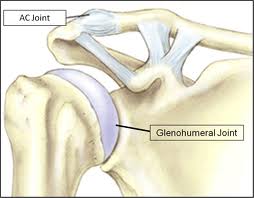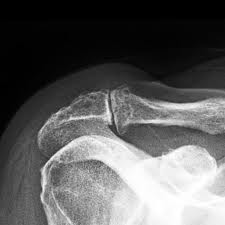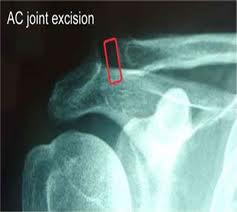The acromioclavicular or AC joint is the site where the shoulder girdle, which includes the arm and the shoulder blade, attaches to the axial skeleton through the clavicle. This acromioclavicular joint is a common place of injury and can be a common source of shoulder pain. A variety of sports activities can lead to injuries, pain and sometimes instability of the acromioclavicular joint.
Anatomy:
The scapula is the large bone in the upper back which is surrounded by the scapular rotator muscles. This scapula has the socket portion of the shoulder attached to it. The humeral head or ball portion of the shoulder attaches to the socket through a series of rotator cuff muscles which dynamically position the ball in the socket. This is all held up to the axial skeleton at the clavicle through fairly strong ligaments at the acromioclavicular joint. These ligaments attach from a portion of the scapula called the coracoid process and actually hold the shoulder girdle up to the clavicle. Injuries to the AC joint are often thought of as the clavicle rising up and becoming prominent. However, these injuries are actually the shoulder girdle dropping down when the ligaments are injured that hold the shoulder girdle up to the clavicle. This connection between the clavicle and the acromion is not a typical joint such as the knee, hip or ankle. Although it is often described as developing osteoarthritis, I prefer to describe it as joint arthrosis as it is not a true synovial joint. The term osteoarthritis hass a whole different type of connotation to patients, and I prefer to separate this out and call this AC joint arthrosis when it occurs.
Causes:
Degeneration of the acromioclavicular joint usually occurs because of an injury that one may have had when they were young. The optimal position of the clavicle on the acromion is disrupted because of a previous injury or shoulder separation. Over time, because the two bones are not positioned exactly right, it wears out and develops arthrosis. Additionally, significant overuse such as weightlifting and heavy work duties can also wear this joint out and lead to the condition called AC joint arthrosis.
Symptoms:
Basically, AC joint arthrosis causes pain. It is usually activity related pain. It is fairly specific to the top or sometimes the front of the shoulder, and symptoms can radiate into the upper scapular rotators into the neck to some extent. This pain is usually exacerbated by things that bring the arm across the body or cause compression across the joint such as weightlifting and lifting heavy objects or doing things away from the body. Occasionally one will have symptoms of popping and clicking associated with this, but this is not always the case.
Diagnosis:
Diagnosis of AC joint arthrosis is very typically clinical. It hurts right over the AC joint and is reproduced by certain provocative maneuvers such as cross-body adduction done in the office on physical examination.
examination.
X-rays also can confirm this by showing typical findings of AC joint arthrosis, bone spur formation, subchondral cyst formation, and complete loss of the normal discoid space between the two bones. If one is not clear on the true pain generator, sometimes a test dose of numbing medicine can be placed into the joint and resolution of pain symptoms confirms the diagnosis.
Treatment:
The treatment of AC joint arthrosis is fairly straight forward. One has two options with this; they can either live with it and adjust their activity levels down to what it lets them do, or they can fix it. Fixing it involves a minimally invasive shoulder arthroscopic surgery to separate these two bones. Bone spur formation is addressed at the same time, and although the ligaments are not destabilized at all, enough of the distal clavicle is resected so that the two bones do not rub together anymore. That usually fixes the problem. Antiinflammatory medications can help with the symptoms although they do not really address the specific problem. Cortisone shots are typically not effective for any significant length of time. Physical therapy does not play a big role in this as the more active one; is the more pain one is going to have. So, it is a fairly straightforward discussion to patients on the treatment plan because one either has to kind of live with it and adjust their activity level to what it lets them do or address it from an arthroscopic standpoint.
any significant length of time. Physical therapy does not play a big role in this as the more active one; is the more pain one is going to have. So, it is a fairly straightforward discussion to patients on the treatment plan because one either has to kind of live with it and adjust their activity level to what it lets them do or address it from an arthroscopic standpoint.
Rehabilitation:
After shoulder arthroscopic surgery, the rehab is fairly straightforward, and this is described in the shoulder rehab section of this website. There is not a lot of recovery that is required to take place. There is not a significant postoperative period of restricted activities, but it is important that one learns the core strengthening exercises of the rotator cuff and the scapular rotator muscles to maximum their shoulder function post arthroscopic surgery. Most return to activity occurs within the first three to six weeks.